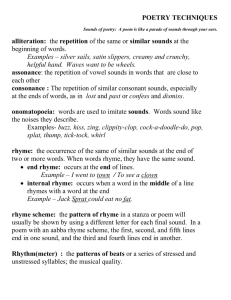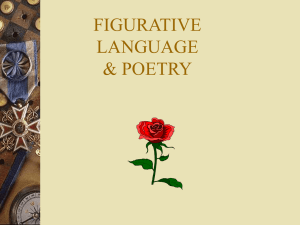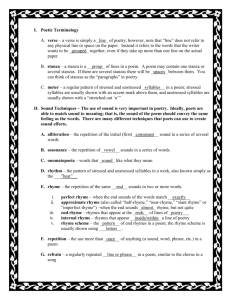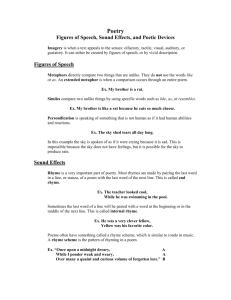Poetry's Language
advertisement
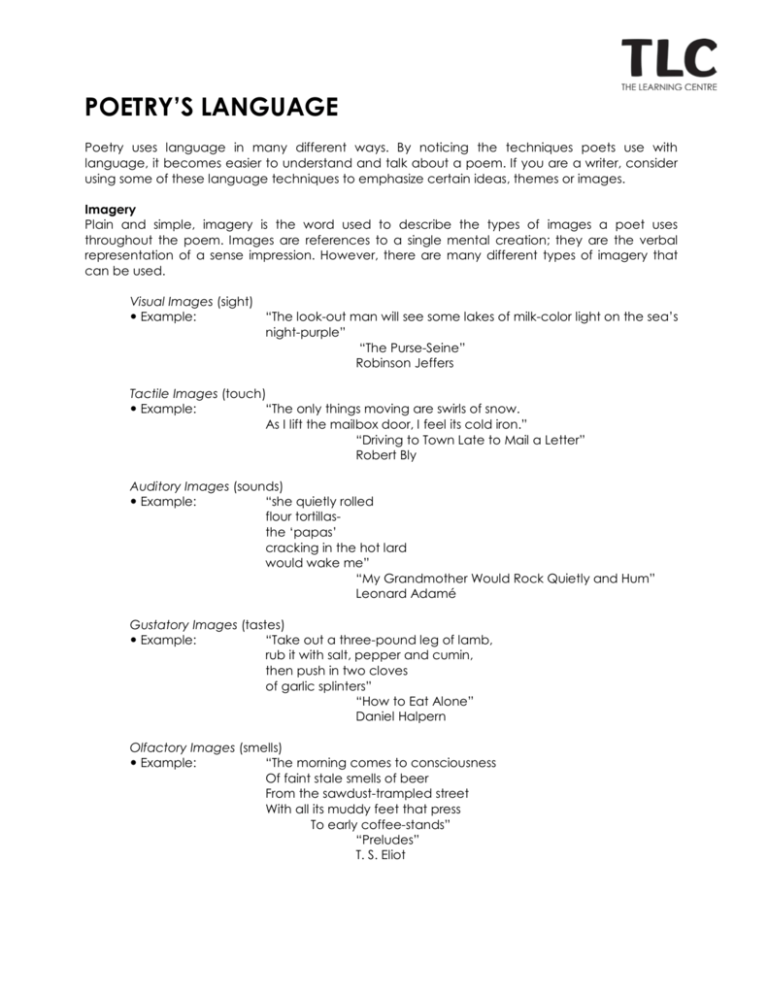
POETRY’S LANGUAGE Poetry uses language in many different ways. By noticing the techniques poets use with language, it becomes easier to understand and talk about a poem. If you are a writer, consider using some of these language techniques to emphasize certain ideas, themes or images. Imagery Plain and simple, imagery is the word used to describe the types of images a poet uses throughout the poem. Images are references to a single mental creation; they are the verbal representation of a sense impression. However, there are many different types of imagery that can be used. Visual Images (sight) Example: “The look-out man will see some lakes of milk-color light on the sea’s night-purple” “The Purse-Seine” Robinson Jeffers Tactile Images (touch) Example: “The only things moving are swirls of snow. As I lift the mailbox door, I feel its cold iron.” “Driving to Town Late to Mail a Letter” Robert Bly Auditory Images (sounds) Example: “she quietly rolled flour tortillasthe ‘papas’ cracking in the hot lard would wake me” “My Grandmother Would Rock Quietly and Hum” Leonard Adamé Gustatory Images (tastes) Example: “Take out a three-pound leg of lamb, rub it with salt, pepper and cumin, then push in two cloves of garlic splinters” “How to Eat Alone” Daniel Halpern Olfactory Images (smells) Example: “The morning comes to consciousness Of faint stale smells of beer From the sawdust-trampled street With all its muddy feet that press To early coffee-stands” “Preludes” T. S. Eliot Diction Diction is the type of words poets choose to use in their poems. A poem that uses slang expressions can be just as powerful as a poem that uses a lot of big words. And feel free to mix up your diction in a poem. There is no reason why you have to use just one. Formal Diction: Words that appear a bit more elegant or extravagant. Often formal diction will contain words that are polysyllabic (many syllables). Neutral Diction: Words that appear ordinary and that you hear everyday. Contractions are often used in poetry that has neutral diction, as well as a simpler vocabulary. Informal Diction: Words and phrases that are slang expressions, or the colloquial – the language of relaxed activities and friendly conversations. Rhyme A poem does not have to rhyme. However, rhyme can be an important part of poetry, and there are many different types of rhyme. Exact (perfect) rhymes: Words that rhyme because both the concluding consonant and vowel sounds rhyme. Example: “Then be not coy, but use your time; And while ye may, go marry: For having lost but one your prime, You may for ever tarry” “To the Virgins, to Make Much of Time” Robert Herrick Inexact (near) rhymes: Words that rhyme because they have similar, not identical, sounds, like bleak/break and loud/bird. Example: “Between my finger and my thumb The squat pen rests; sung as a gun.” “Digging” Seamus Heaney End rhymes: Words at the ends of lines that rhyme, either exactly or inexactly. Example: “The massive weight of Uncle’s wedding band Sits heavily upon Aunt Jennifer’s hand” “Aunt Jennifer’s Tigers” Adrienne Rich Internal rhymes: Words in the beginning or middle of a line that rhyme with each other, either exactly or inexactly. Example: “And I who gave Kate a blackened eye Did to its vivid changing colours Make up an incredible musical scale” “Whatever Else Poetry is Freedom” Irving Layton Techniques and Devices There are many other tools that poets use to achieve a certain sound or rhythm Alliteration The repetition of a consonant sound in the beginning of words that are found close together in a line. Example: “O wild West Wind, thou breath of Autumn’s being” “Ode to the West Wind” Percy Bysshe Shelley Assonance The repetition of similar vowel sounds in words that are close to each other in a line. Example: “...and let the coffee-pot boil over on the stove” “Living in Sin” Adrienne Rich Consonance The repetition of identical consonant sounds but different vowel sounds found close together in a line Example: “And broils root out of the work of masonry” “Not Marble Nor the Guilded Monuments” William Shakespeare Euphony When the sounds of words in a line create an effect that is pleasing to the ear Example: “There is no silence upon the earth or under the earth like the silence under the sea” “Silences” E.J. Pratt Cacophony The opposite of euphony, when the sounds of words in a line create a discordant or jarring effect when heard Example: “For growl and cough and snarl are the tokens of spendthrifts Who know not the ultimate economy of rage” “Silences” E.J. Pratt Onomatopoeia Words that imitate a sound; a verbal echo of the action being described, such as buzz, hum, slap Example: “I hear quiet clicks, cups of black coffee, click, click like facts” “Sonrisas” Pat Mora Figure of speech An expression where certain words are arranged in a particular way to achieve a particular effect. The following are all different figures of speech commonly used in poetry: Metaphor A comparison device where two things are compared directly. Something will be described as though it is actually something else. Example: “The apparition of these faces in the crowd; Petals on a wet, black bough.” “In a Station of the Metro” Ezra Pound Simile A comparison device where “like” or “as” is used as the clause. Example: “Eyes like the morning star, Cheeks like a rose” “The Colorado Trail” Anonymous Apostrophe Words that are addressed to an absent or imaginary person, an object, or an abstract thought Example: “Love, O love, O careless love” “Careless Love” Anonymous Denotation The precise definition of a word, the “dictionary” meaning Connotation All the meanings, definitions or associations that a word suggests



